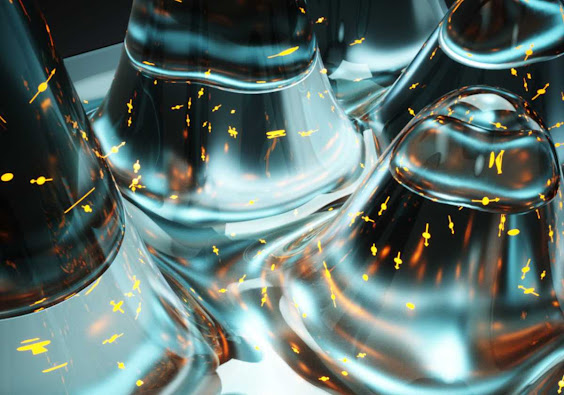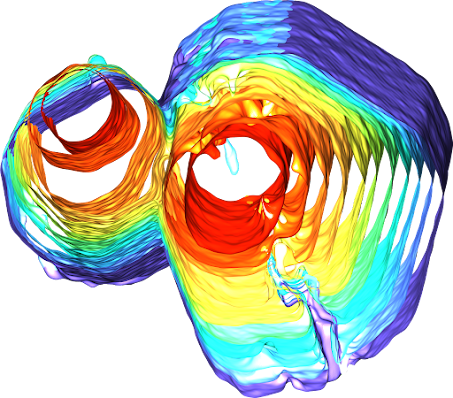A bill under debate in Congress would pave the way to verifying and paying for farms’ carbon savings. Stanford scientists explore this and other opportunities for growing climate change solutions on U.S. farms.
Source/Credit: Stanford University
A bill under debate in Congress would pave the way to verifying and paying for farms’ carbon savings. Stanford scientists explore this and other opportunities for growing climate change solutions on U.S. farms.
Source/Credit: Stanford University
 |
| Artist’s illustration of hydrodynamical behavior from an interacting ensemble of quantum spin defects in diamond. (Credit: Norman Yao/Berkeley Lab) |
Now, researchers are developing new pathways to create and protect quantum coherence. Doing so will enable exquisitely sensitive measurement and information processing devices that function at ambient or even extreme conditions. In 2018, Joel Moore, a senior faculty scientist at Lawrence Berkeley National Laboratory (Berkeley Lab) and professor at UC Berkeley, secured funds from the Department of Energy to create and lead an Energy Frontier Research Center (EFRC) – called the Center for Novel Pathways to Quantum Coherence in Materials (NPQC) – to further those efforts. “The EFRCs are an important tool for DOE to enable focused inter-institutional collaborations to make rapid progress on forefront science problems that are beyond the scope of individual investigators,” said Moore.
 |
| A young southern resident killer whale calf (J56) carrying a dead fish between her teeth while swimming next to her mother (J31) in the Salish Sea. Credit: A.W. Trites/University of British Columbia |
In a paper published today in the Canadian Journal of Fisheries and Aquatic Sciences, researchers report that the numbers of Chinook salmon in the Salish Sea in summertime are four to six times more abundant for southern resident killer whales than northern resident killer whales.
“People have been talking about a prey shortage as if it’s a fact, but this is the first study to quantify and compare the amount of their preferred prey, Chinook salmon, available to southern and northern resident killer whales,” said lead author Dr. Mei Sato (she/her), a research associate at the Institute for the Oceans and Fisheries at UBC at the time of the study, and now an assistant scientist at Woods Hole Oceanographic Institution.
The scientists analyzed local air quality measurements in combination with atmospheric data and found that oil and gas wells are emitting toxic particulate matter (PM2.5), carbon monoxide, nitrous oxide, ozone and volatile organic compounds (VOCs). The findings, which appear in the journal Science of the Total Environment, will help researchers determine how proximity to oil and gas wells may increase the risk of adverse health outcomes, including preterm birth, asthma and heart disease.
“In California, Black and Latinx communities face some of the highest pollution from oil and gas wells. If we care about environmental justice and making sure every kid has a chance to be healthy, we should care about this,” said lead author David Gonzalez, who conducted research for the study while a PhD student in Stanford’s Emmett Interdisciplinary Program in Environment and Resources (E-IPER). “What’s novel about our study is that we’ve done this at a population, state-wide scale using the same methods as public health studies.”
The findings align with other smaller-scale studies that have measured emissions from a handful of wells. At least two million Californians live within one mile of an active oil or gas well.
 |
| This poster shows 42 of the largest objects in the asteroid belt, located between Mars and Jupiter (orbits not to scale). The images in the outermost circle of this infographic have been captured with the Spectro-Polarimetric High-contrast Exoplanet REsearch (SPHERE) instrument on ESO’s Very Large Telescope. The asteroid sample features 39 objects larger than 100 kilometers in diameter, including 20 larger than 200 kilometers. The poster highlights a few of the objects, including Ceres (the largest asteroid in the belt), Urania (the smallest one imaged), Kalliope (the densest imaged) and Lutetia, which was visited by the European Space Agency’s Rosetta mission. Credit: ESO/M. Kornmesser/Vernazza et al./MISTRAL algorithm (ONERA/CNRS) Click Here For Hi-Res Zoomable Image |
The detailed images of these 42 objects are a leap forward in exploring asteroids, made possible thanks to ground-based telescopes, and contribute to answering the ultimate question of life, the Universe, and everything.
“Only three large main belt asteroids, Ceres, Vesta and Lutetia, have been imaged with a high level of detail so far, as they were visited by the space missions Dawn and Rosetta of NASA and the European Space Agency, respectively,” explains Pierre Vernazza, from the Laboratoire d’Astrophysique de Marseille in France, who led the asteroid study published today in Astronomy & Astrophysics. "Our ESO observations have provided sharp images for many more targets, 42 in total."
The previously small number of detailed observations of asteroids meant that, until now, key characteristics such as their 3D shape or density had remained largely unknown. Between 2017 and 2019, Vernazza and his team set out to fill this gap by conducting a thorough survey of the major bodies in the asteroid belt.
Most of the 42 objects in their sample are larger than 100 km in size; in particular, the team imaged nearly all of the belt asteroids larger than 200 kilometers, 20 out of 23. The two biggest objects the team probed were Ceres and Vesta, which are around 940 and 520 kilometers in diameter, whereas the two smallest asteroids are Urania and Ausonia, each only about 90 kilometers.
By reconstructing the objects’ shapes, the team realized that the observed asteroids are mainly divided into two families. Some are almost perfectly spherical, such as Hygiea and Ceres, while others have a more peculiar, “elongated” shape, their undisputed queen being the “dog-bone” asteroid Kleopatra.
By combining the asteroids’ shapes with information on their masses, the team found that the densities change significantly across the sample. The four least dense asteroids studied, including Lamberta and Sylvia, have densities of about 1.3 grams per cubic centimeter, approximately the density of coal. The highest, Psyche and Kalliope, have densities of 3.9 and 4.4 grams per cubic centimeter, respectively, which is higher than the density of diamond (3.5 grams per cubic centimeter).
This large difference in density suggests the asteroids’ composition varies significantly, giving astronomers important clues about their origin. “Our observations provide strong support for substantial migration of these bodies since their formation. In short, such tremendous variety in their composition can only be understood if the bodies originated across distinct regions in the Solar System,” explains Josef Hanuš of the Charles University, Prague, Czech Republic, one of the authors of the study. In particular, the results support the theory that the least dense asteroids formed in the remote regions beyond the orbit of Neptune and migrated to their current location.
These findings were made possible thanks to the sensitivity of the Spectro-Polarimetric High-contrast Exoplanet REsearch (SPHERE) instrument mounted on ESO’s VLT. “With the improved capabilities of SPHERE, along with the fact that little was known regarding the shape of the largest main belt asteroids, we were able to make substantial progress in this field,” says co-author Laurent Jorda, also of the Laboratoire d'Astrophysique de Marseille.
Astronomers will be able to image even more asteroids in fine detail with ESO’s upcoming Extremely Large Telescope (ELT), currently under construction in Chile and set to start operations later this decade. “ELT observations of main-belt asteroids will allow us to study objects with diameters down to 35 to 80 kilometers, depending on their location in the belt, and craters down to approximately 10 to 25 kilometers in size,” says Vernazza. “Having a SPHERE-like instrument at the ELT would even allow us to image a similar sample of objects in the distant Kuiper Belt. This means we’ll be able to characterize the geological history of a much larger sample of small bodies from the ground.”
Source/Credit: ESO (European Southern Observatory)
sn101221_01
 |
| An X-ray tomography visualization shows a top-down view of two quasicrystals as they start to meld together during cooling. Image credit: Shahani Group, University of Michigan |
Published in Nature Communications, the study demonstrates a way to make much larger quasicrystals than were possible before, without the defects that plagued past manufacturers and led quasicrystals to be dismissed as an intellectual curiosity.
“One reason why industry gave up on quasicrystals is because they’re full of defects,” said Ashwin Shahani, U-M assistant professor of materials science and engineering and chemical engineering and a corresponding author on the paper. “But we’re hoping to bring quasicrystals back into the mainstream. And this work hints that it can be done.”
The University of Queensland’s Dr Benjamin Pope and colleagues at the Dutch national observatory ASTRON have been searching for planets using the world’s most powerful radio telescope Low Frequency Array (LOFAR) situated in the Netherlands.
“We’ve discovered signals from 19 distant red dwarf stars, four of which are best explained by the existence of planets orbiting them,” Dr Pope said.
“We’ve long known that the planets of our own solar system emit powerful radio waves as their magnetic fields interact with the solar wind, but radio signals from planets outside our solar system had yet to be picked up.
“This discovery is an important step for radio astronomy and could potentially lead to the discovery of planets throughout the galaxy.”
Previously, astronomers were only able to detect the very nearest stars in steady radio emission, and everything else in the radio sky was interstellar gas, or exotica such as black holes.
Marine plankton breathe more than 20 million tons of sulfur into the air every year, mostly in the form of dimethyl sulfide (DMS). In the air, this chemical can transform into sulfuric acid, which helps produce clouds by giving a site for water droplets to form. Over the scale of the world’s oceans, this process affects the entire climate.
But new research from the University of Wisconsin–Madison, the National Oceanic and Atmospheric Administration and others reveals that more than one-third of the DMS emitted from the sea can never help new clouds form because it is lost to the clouds themselves. The new findings significantly alter the prevailing understanding of how marine life influences clouds and may change the way scientists predict how cloud formation responds to changes in the oceans.
In response to drought, cold, lack of sunlight and other stress, cellular proteins interact in different ways to help a plant survive. A primary protective act is the destruction and recycling of some of the plant’s own cellular materials into what is needed for others.
A Purdue University-led research team has identified proteins involved in this protective process and discovered how they act upon each other. A better understanding of these mechanisms could lead to ways to help plants withstand severe conditions.
 |
| KTH scientist Xiong Xiao uses ultrasound in combination with acetic acid and citric acid, instead of sulfuric acid, to extract the metals from the batteries. Photo: Peter Ardell |
Is it possible to extract metals from a lithium battery in half the time it normally takes? Is it possible to use acids that are common in most homes worldwide for the extraction process? The answer is yes. Scientists at KTH have discovered a way.
In a scientific article published by the journal Green Chemistry scientist Xiong Xiao, a postdoc at the Division of Polymeric Materials at KTH, explains how it works using ultrasound.
“We perform the metal extraction in half the time it normally takes and we take out more metal ion than normally reported in scientific literature. In the extraction process we use mild acids such as acetic acid and citric acid instead of sulfuric acid, which is very beneficial from a work environment and sustainable development point of view,” says Xiong Xiao.
The researchers’ findings raise concerns about how climate change may affect the levels of methylmercury in fish and shellfish. Photo Credit...
